By Michael Blanding
Since its founding in 1950, the National Science Foundation (NSF) has played a pivotal role in the development of scientific knowledge, supporting basic research that often leads to breakthrough discoveries in ways private industry or academic institutions alone often cannot undertake. At URI‘s Graduate School of Oceanography, NSF has been funding ocean research and discovery, from uncovering the secrets of coastal estuaries and deep-sea microbial life to designing autonomous robots and mapping global carbon and nitrogen cycles. Many of those insights have come aboard expeditions on the R/V Endeavor, the 185-foot research vessel owned by the NSF and operated by GSO for nearly five decades, traveling more than a million miles on hundreds of expeditions across the globe. It will soon be replaced by a new state-of-the-art NSF vessel, the 199-foot R/V Narragansett Dawn—one of only three new regional research vessels across the country—which will open a new chapter of ocean exploration. As the following reflections of GSO alumni and faculty make clear, the enduring legacy of NSF support at GSO is one of empowering scientists, asking bold questions, and defining an agenda for discoveries that have shaped how we understand our ocean planet.
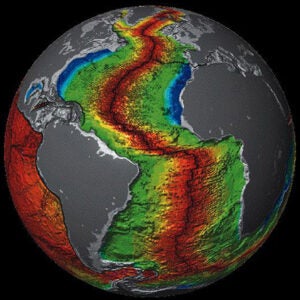
Leadership in Research
“The NSF is so important in supporting basic observations.”
Jim Yoder, M.S. ’74, Ph.D. ’79
Emeritus Professor of Oceanography, URI
As director of NSF’s Division of Ocean Sciences from 2001 to 2004, I saw firsthand how critical NSF funding is for oceanographic institutions, including URI. The NSF is the government agency that really focuses on supporting basic research, independent of whether there’s immediate societal benefits recognized or not. Other funding streams may emphasize immediate practical needs; NSF looks further down the road and says, no, we’re going to fund basic research because we know from past experience that a lot of it will eventually turn into new products and discoveries that will help people. Since GSO’s founding in the early 1960s, the NSF h“The NSF is so important in supporting basic observations.”as been the single largest source of money for ocean research, ships, and the operation of vessels. In my time at GSO, I’ve seen multiple grants, including a massive effort to characterize the ocean’s phytoplankton when I was a graduate student, to more recent grants on ocean drilling that have discovered living organisms in sediments a mile deep, setting the field off in new directions. Earlier this year, I was one of several URI researchers who authored a report on the crucial need for the United States to invest in ocean science research for infrastructure, national security and environmental sustainability. The changes we are seeing in the ocean due to climate are impacting reefs and fisheries and the severity of ocean storms, and it’s important we project into the future what those impacts will be. It’s critical to keep basic research going in this country, because of the unanticipated discoveries that lead to important societal benefits, the critical funding for ocean-going vessels, and the major support for graduate students that helps fuel the pipeline for the next generation of ocean scientists.
Alexandra Isern, M.S. ’90
Executive Director, Summit Science Solutions; Former Assistant Director, Directorate for Geosciences, National Science Foundation
I got my master’s at GSO on an NSF grant line working with geosciences Professor Michael Bender to look at fluxes of carbon and organic matter on a transect across the equator. That was the start of my research, and it helped to provide fundamental data for so many other studies looking at the fall of particles to the sea floor, which is such a critical part of the carbon cycle. After that, I was at the NSF for 24 years; I spent the first six in Ocean Science, then moved over to the Antarctic program, eventually directing the Antarctic Sciences section, before I was given the position of assistant director for four years. One of my biggest accomplishments was to tie together disparate research areas to create dialogue across agencies that doesn’t necessarily occur in some other areas of science. The NSF is so important in supporting basic observations with bio-, geo-, and chemical floats around the world that agencies such as NOAA and companies such as AccuWeather use to predict the weather. Industries around the world benefit from these tools they could never afford to invest in themselves. They are critical for understanding the carbon cycle, which we are still continuing to investigate since my time as a graduate student. And NSF also provides critical support for the academic fleet, ocean drilling, underwater gliders, and basic research allowing us to predict sea-level rise, ocean circulation, and the impact of ocean warming on coral reefs and fisheries. The world-class researchers at URI have always been good investments, not just as researchers, but also as collaborators, serving on panels to review grants and advisors to help set the priorities of the foundation.
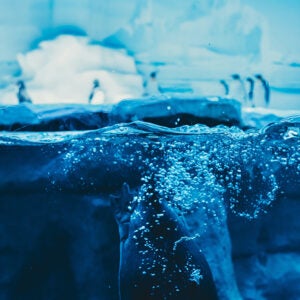
Exploring the Deep
“R/V Endeavor has sailed well over a million miles…really all over the world.“
Mingxi Zhou
Associate Professor of Oceanography, URI
In my lab, we work on marine robotic systems, including autonomous and semi-autonomous vehicles. Most of the time we focus on navigating challenging environments. My first NSF-related project was working in an under-ice environment where you don’t have a lot of features for the camera to use to navigate. We have a sensor fusion algorithm that uses doppler radar and other sensors to enhance the image, so you can reconstruct what the ice surface looks like underwater, at the same time measuring dissolved oxygen, salinity, and other water properties. Scientists who are interested in measuring changes in ice want to operate the vehicle at the ice-water interface, and this allows them to operate close to the ice to get those measurements. We have another NSF-funded project using an autonomous surface vehicle and an autonomous underwater vehicle to work together to map moving icebergs. Finally, I received a prestigious NSF CAREER award for early-career faculty on helping robots live underwater longer. This involves a system in which a docking station is attached to a cable that allows the robot to recharge underwater without the aid of a ship, so it can continue to collect measurements far from shore or during dangerous conditions. Our fundamental contribution is using a light source at an available underwater docking station that allows the vehicle to measure relative distance based on a camera image. We are also working on using a machine learning neural network to do system identification to improve control and docking ability. This is primarily for research applications, but we are also looking into commercialization opportunities. The NSF has been helpful in supporting our fundamental research, including building an open-source autonomous underwater vehicle. Researchers can order designs and a circuit board and software that allows them to build their own, or they can talk to us to help them, allowing them to conduct their own research underwater.
Tom Glennon
Former Director of Marine Operations, URI
The NSF-owned R/V Endeavor is currently sailing in its 49th year, and it’s done over 700 cruises. It’s been a real feather in the cap of URI, especially considering its two sister ships were retired five and ten years ago—but we’ve kept it going through the great support of the marine office and the crew. I started at GSO in 2000 as a port engineer for the Endeavor, then I became director of marine operations from 2011 to 2022. It was my job to schedule the vessel, getting as many scientific cruises done as we could handle, as well as keeping the ship within regulations for the Coast Guard and international safety organizations and doing inspections and maintenance. The ship has sailed well over a million miles, from Svalbard in the north to Tristan de Cunha in the south, through the Mediterranean and the Black Sea, through the Panama Canal and Hawaii—really all over the world. We can take up to 18 scientists from different universities, and it’s an open platform for whatever equipment they want to bring. They’ve done all kinds of physical oceanography, investigating undersea volcanoes and taking deep-ocean cores, as well as biological sampling and marine mammal observations. The ship costs $5 million a year, and the NSF has historically provided 70 percent of that, making them far and away our biggest funder. They also fund UNOLS—the University National Oceanographic Laboratory System—which helps coordinate and schedule the scientific missions. Now I’m working part-time at GSO, working mostly as shipyard representative for the new research vessel, Narragansett Dawn, which is being built down in Louisiana. It will provide a better platform with more scientific capabilities in terms of sensors and advanced equipment, which will allow scientists to do even more than they are able to do now. We’re very excited for the new vessel, which will keep URI on the leading edge of oceanographic research for many years to come.
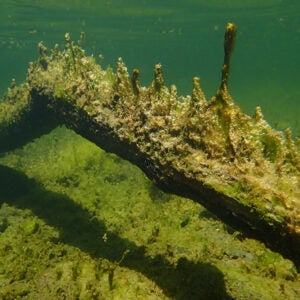
Protecting Coastal Waters
“The NSF funding really helped me to think not only about local problems, but also about implications at a global scale.”
Barb Nowicki, M.S. ’83
Ph.D. ’91, Former Research Scientist, URI
I started at GSO in 1975 as a lab technician and then went on to get my master’s and Ph.D. Most of my work was done in coastal areas in Rhode Island and Massachusetts, looking at the nitrogen cycle. If you have a lot of nitrogen coming in from septic systems and sewage treatment plants, you fuel a lot of algal blooms, and then when those algal blooms crash and die, they use up all the oxygen in the system, which leads to massive fish kills. The NSF funded research to look at salt marshes around Narragansett Bay. I used to hire a bunch of URI football players in the summer who were strong enough to dig wells for us, and we would go into the marshes and people’s backyards close to the estuaries and sample the groundwater to measure the nitrogen. As you might expect, we found that the septic systems were a major source of nitrogen for coastal marine environments. I also studied a process of denitrification, a bacterial process where bacteria can convert nitrogen into gas that goes harmlessly into the atmosphere. Replacing underground septic systems with above-ground denitrifying septic systems prevents the nitrogen from going into the ocean. I was one of many people working on this issue whose research contributed to changes in siting and design of septic systems, and encouraging some communities to move to sewers instead of individual systems. I’m delighted that I contributed information that helped create the larger picture to inspire these changes—and we could not have done it without NSF funding.
Sybil Seitzinger, Ph.D. ’82
Professor Emerita and American Geophysical Union Fellow, University of Victoria
I had two NSF grants as a student at GSO. They allowed me to not only support my graduate work, but also provided me with funding for travel and equipment, as well as a research assistant, which was critical to what we were doing. The funding allowed me to develop the first technique for directly measuring denitrification in coastal sediments. There was a lot of excess nitrogen coming into Narragansett Bay, and I discovered a microbial process going on in the sediment in estuaries in a low-oxygen environment that was removing some of that nitrogen by binding it so it was not getting exported to the continental shelf. After leaving GSO, I continued getting funding from NSF for a number of years to look at estuaries around the world, leading to a bigger view of the global nitrogen cycle, and pointing to the importance of estuaries in removing nitrogen that could be harmful in terms of excess algal blooms. The NSF funding really helped me to think not only about local problems, but also about implications at a global scale. I led a U.N. working group that brought together amazing colleagues from Europe and Asia to develop a global watershed model, and that led me to be nominated to be executive director for the International Global Biosphere Program out of Stockholm. In part funded by the NSF’s Global Centers Program, I helped thousands of scientists all over the world looking at water usage, nutrient dynamics, and ocean ecosystems.
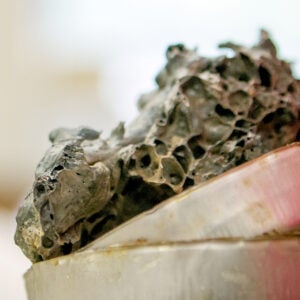
Understanding the Ocean Floor
“The NSF recognized there was a lot of value in preserving these minerals.”
Katie Kelley
Professor of Oceanography, URI; Co-Curator, Marine Geological Samples Lab
The MGSL is like a library of samples from the ocean floor that takes materials collected by marine expeditions and makes them available for future scientific work. Picture a very tall warehouse with rock collections organized in stacks; you can consult a catalog and pull out a drawer where certain rocks are kept. We also have a core refrigerator that keeps sediment cores at very cold temperatures in long tubes about a meter and a half in length. The MGSL began in the 1980s when the NSF recognized there was a lot of value in preserving these materials they’d spent a lot of money to collect. Our rock collections now cover an enormous part of the ocean floor, mostly along the mid-ocean ridge system, which is a globally interconnected volcanic chain in the Earth’s ocean basins. We’re the only repository that has a large number of samples from this particular spreading center, the world’s largest, which can tell us a lot about what the Earth’s interior is like. The core collection allows researchers to access individual layers of mud going back millions of years, so they can analyze paleoclimatic conditions to inform how climate is changing today. Our samples are open access to communities of requesters from around the world, whether it’s an academic researcher, government agency, or private industry. The NSF support is crucial to the future sustainability of our repository, covering half the funding of our curator, as well as two full-time graduate student assistants. My own NSF grants look at underwater volcanoes, collecting samples to explain why volcanoes sometimes appear at places away from the Earth’s tectonic plate boundaries. Another grant makes use of the existing collections at the MGSL as well as other marine repositories to characterize the geochemistry of the global mid-ocean ridge to better understand how plate tectonics works.
Becky Robinson
Professor of Oceanography, URI; Co-Curator, Marine Geological Samples Lab
I am a geologist by training, and my primary research interests have been changes in ocean chemistry and biology over thousands to millions of years. I’m really interested in the Southern Ocean in particular, and how it works to regulate climate change. The NSF has funded me several times to work on both sediment cores and the water column in the Antarctic to understand how one group of organisms, called diatoms, record ocean chemistry. These diatoms are photosynthetic algae that build these little glass shells out of silicon, and when they die, the shells sink to the sea floor and become buried. Within those fossils are nitrogen and carbon molecules that record the chemistry of the surface ocean, encapsulated in glass by these biominerals over tens of millions of years. This past October, I went down to the Southern Ocean during the spring bloom, getting on a boat in Chile and taking a quick stop in Antarctica before setting out across the Pacific. We traversed the sea in an ice breaker, plowing through the pancakes along the edge of the ice all the way to 170 West Longitude, which is quite close to New Zealand. Once there, we started working our way northwards, and at every degree of latitude we stopped the ship and dropped a big water sampling carousel over the side with 24, long 12-liter bottles to collect water at different depths, along with information from sensors to measure temperature, salinity, oxygen, and fluorescence.
By examining the diatoms in these samples, we see how they embed the ocean chemistry in specific signatures, that can help us better optimize our understanding of these signatures in diatoms of the past. We can use that to understand how warming trends in the past have changed ocean circulation, and distinguish between oceanographic processes occurring naturally and those caused by man-made climate change.
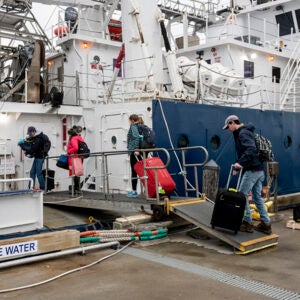
Expanding Sea of Opportunities
“Having another person in the room who looks like you…makes all the difference.”
Kathy Donohue, Ph.D. ’95
Professor of Oceanography, URI
The NSF has been a huge supporter of my work for many years. As a grad student at GSO, I was interested in looking at how by observing how currents move in the modern day we might be able to reconstruct paleocurrents millions of years ago. I was fortunate enough to find a postdoc position at the University of Hawaii supported by NSF funding to look at circulation in the Indian Ocean. When I came back to URI, I was able to use some of this money to fund salary at GSO, but I never thought about a faculty position, until a group of women in STEM across URI applied for an ADVANCE grant from the NSF. They had the specific aim to increase the number of women in STEM, giving new hires a two-year fellowship with mentorship and a clear path to a faculty position. The value of having a cohort cannot be overstated—it was a wedge that came in to create space for new people, and had a profound influence on the culture of GSO to make it more flexible and family-friendly. Just having another person in the room who looks like you to give you perspective and practical advice makes all the difference. Since becoming a faculty member, the NSF has frequently funded my work; currently, I have two grants to observe ocean currents in the Southern Ocean, looking at how the ocean moves heat and other properties to maintain our climate. The great thing about NSF funding is that it comes with a fleet of U.S. vessels—or the ability to buy ship time on non-US vessels—that allows you to reach difficult and remote places. In addition to my research, one of the most rewarding experiences I’ve had in my career is working on NSF-funded Summer Undergraduate Research Fellowship in Oceanography (SURFO) program, giving authentic research experiences to undergraduates and helping to build a vibrant oceanographic community.
Andria Miller, M.S. ’23
Ocean Science and Outreach Coordinator, Jackson State University
I applied to the SURFO program right before the pandemic started in 2020, and unlike other programs I applied to, GSO was open to having me do a virtual program, where I could conduct sampling at home and work on analysis collaboratively with URI scientists. I was born and raised in Jackson, Mississippi, and always loved the ocean; even at 5 years old, I was looking for mermaids during beach vacations. But no one really encouraged me in that dream until a professor at Jackson State persuaded me to jump into a marine sciences concentration, and it changed my life. The SURFO program helped me connect marine biology to chemistry, physics, and geology, and understand how biological aspects are affected by all of those other systems. For my project sampling plankton from local lakes, I ended up making my own oceanographic instruments, including a plankton net made from a lampshade and a stocking, and examined them using a borrowed microscope to try and understand the community compositions.
I gained so much from the experience, including patience, ability to collaborate, and lifelong mentorship from Professor Susanne Menden-Deuer and postdoctoral fellow Pierre Marrec. At the same time, I joined Black in Marine Science, and ended up on a Zoom call where I saw so many more Black people in the field—it was a tear-jerking experience, and gave me so much motivation to get through the summer. Afterwards, I came to URI to continue studies on phytoplankton communities as a master’s student, and since then, I’ve come back to Jackson State where I now conduct ocean science education for students from kindergarten to college. It’s been a full-circle moment, living my dream every day. I’m now in the position to help other people apply for those same internships and master’s programs, encouraging others from different backgrounds to move forward.
